Jinsong Lan
MMKB-RAG: A Multi-Modal Knowledge-Based Retrieval-Augmented Generation Framework
Apr 15, 2025Abstract:Recent advancements in large language models (LLMs) and multi-modal LLMs have been remarkable. However, these models still rely solely on their parametric knowledge, which limits their ability to generate up-to-date information and increases the risk of producing erroneous content. Retrieval-Augmented Generation (RAG) partially mitigates these challenges by incorporating external data sources, yet the reliance on databases and retrieval systems can introduce irrelevant or inaccurate documents, ultimately undermining both performance and reasoning quality. In this paper, we propose Multi-Modal Knowledge-Based Retrieval-Augmented Generation (MMKB-RAG), a novel multi-modal RAG framework that leverages the inherent knowledge boundaries of models to dynamically generate semantic tags for the retrieval process. This strategy enables the joint filtering of retrieved documents, retaining only the most relevant and accurate references. Extensive experiments on knowledge-based visual question-answering tasks demonstrate the efficacy of our approach: on the E-VQA dataset, our method improves performance by +4.2% on the Single-Hop subset and +0.4% on the full dataset, while on the InfoSeek dataset, it achieves gains of +7.8% on the Unseen-Q subset, +8.2% on the Unseen-E subset, and +8.1% on the full dataset. These results highlight significant enhancements in both accuracy and robustness over the current state-of-the-art MLLM and RAG frameworks.
Squeeze Out Tokens from Sample for Finer-Grained Data Governance
Mar 18, 2025Abstract:Widely observed data scaling laws, in which error falls off as a power of the training size, demonstrate the diminishing returns of unselective data expansion. Hence, data governance is proposed to downsize datasets through pruning non-informative samples. Yet, isolating the impact of a specific sample on overall model performance is challenging, due to the vast computation required for tryout all sample combinations. Current data governors circumvent this complexity by estimating sample contributions through heuristic-derived scalar scores, thereby discarding low-value ones. Despite thorough sample sieving, retained samples contain substantial undesired tokens intrinsically, underscoring the potential for further compression and purification. In this work, we upgrade data governance from a 'sieving' approach to a 'juicing' one. Instead of scanning for least-flawed samples, our dual-branch DataJuicer applies finer-grained intra-sample governance. It squeezes out informative tokens and boosts image-text alignments. Specifically, the vision branch retains salient image patches and extracts relevant object classes, while the text branch incorporates these classes to enhance captions. Consequently, DataJuicer yields more refined datasets through finer-grained governance. Extensive experiments across datasets demonstrate that DataJuicer significantly outperforms existing DataSieve in image-text retrieval, classification, and dense visual reasoning.
Advancing Myopia To Holism: Fully Contrastive Language-Image Pre-training
Nov 30, 2024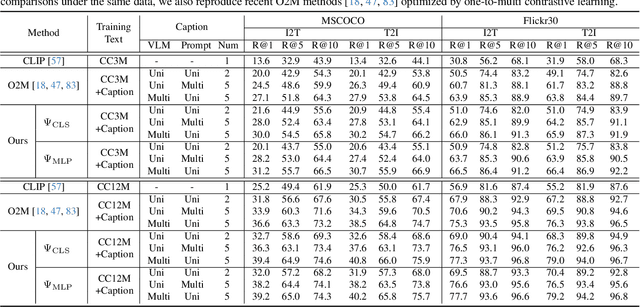
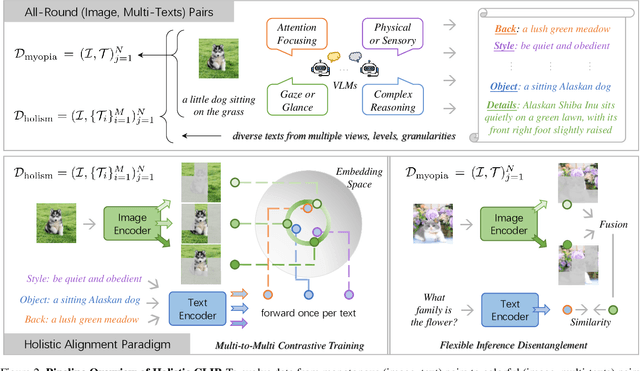
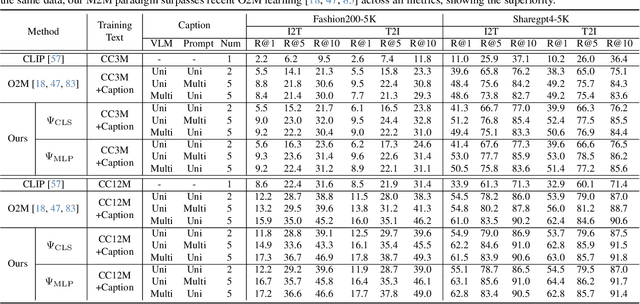
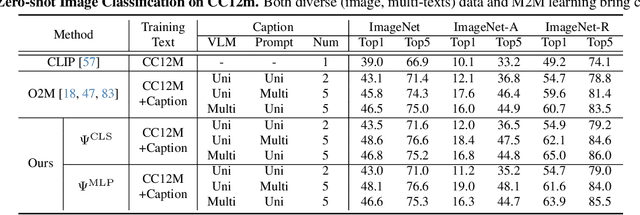
Abstract:In rapidly evolving field of vision-language models (VLMs), contrastive language-image pre-training (CLIP) has made significant strides, becoming foundation for various downstream tasks. However, relying on one-to-one (image, text) contrastive paradigm to learn alignment from large-scale messy web data, CLIP faces a serious myopic dilemma, resulting in biases towards monotonous short texts and shallow visual expressivity. To overcome these issues, this paper advances CLIP into one novel holistic paradigm, by updating both diverse data and alignment optimization. To obtain colorful data with low cost, we use image-to-text captioning to generate multi-texts for each image, from multiple perspectives, granularities, and hierarchies. Two gadgets are proposed to encourage textual diversity. To match such (image, multi-texts) pairs, we modify the CLIP image encoder into multi-branch, and propose multi-to-multi contrastive optimization for image-text part-to-part matching. As a result, diverse visual embeddings are learned for each image, bringing good interpretability and generalization. Extensive experiments and ablations across over ten benchmarks indicate that our holistic CLIP significantly outperforms existing myopic CLIP, including image-text retrieval, open-vocabulary classification, and dense visual tasks.
Branches, Assemble! Multi-Branch Cooperation Network for Large-Scale Click-Through Rate Prediction at Taobao
Nov 20, 2024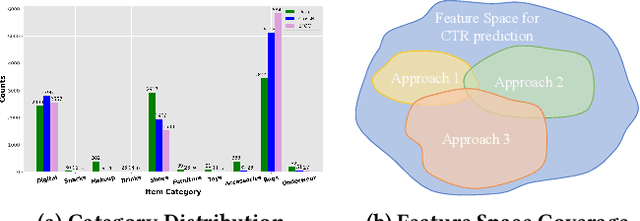
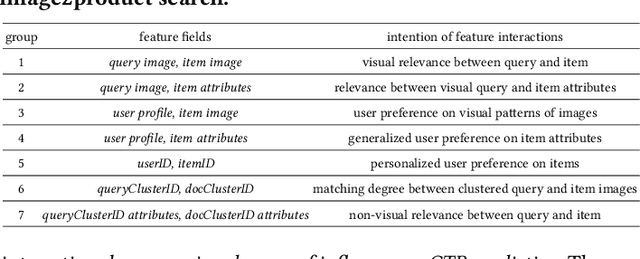
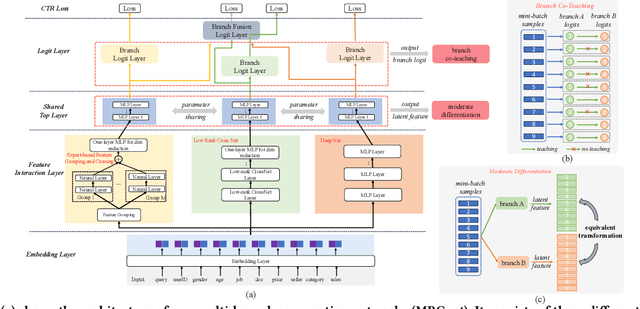

Abstract:Existing click-through rate (CTR) prediction works have studied the role of feature interaction through a variety of techniques. Each interaction technique exhibits its own strength, and solely using one type could constrain the model's capability to capture the complex feature relationships, especially for industrial large-scale data with enormous users and items. Recent research shows that effective CTR models often combine an MLP network with a dedicated feature interaction network in a two-parallel structure. However, the interplay and cooperative dynamics between different streams or branches remain under-researched. In this work, we introduce a novel Multi-Branch Cooperation Network (MBCnet) which enables multiple branch networks to collaborate with each other for better complex feature interaction modeling. Specifically, MBCnet consists of three branches: the Expert-based Feature Grouping and Crossing (EFGC) branch that promotes the model's memorization ability of specific feature fields, the low rank Cross Net branch and Deep branch to enhance both explicit and implicit feature crossing for improved generalization. Among branches, a novel cooperation scheme is proposed based on two principles: branch co-teaching and moderate differentiation. Branch co-teaching encourages well-learned branches to support poorly-learned ones on specific training samples. Moderate differentiation advocates branches to maintain a reasonable level of difference in their feature representations. The cooperation strategy improves learning through mutual knowledge sharing via co-teaching and boosts the discovery of diverse feature interactions across branches. Extensive experiments on large-scale industrial datasets and online A/B test demonstrate MBCnet's superior performance, delivering a 0.09 point increase in CTR, 1.49% growth in deals, and 1.62% rise in GMV. Core codes will be released soon.
Tunnel Try-on: Excavating Spatial-temporal Tunnels for High-quality Virtual Try-on in Videos
Apr 26, 2024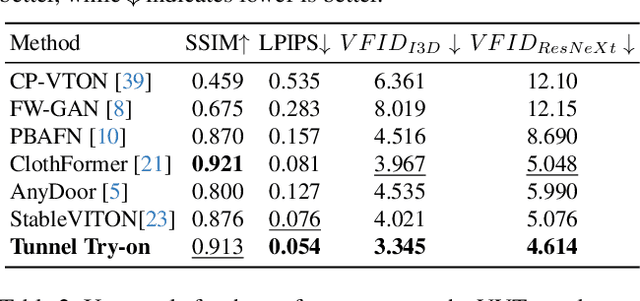
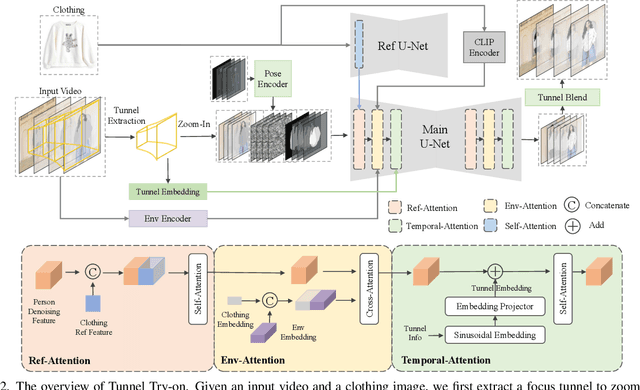
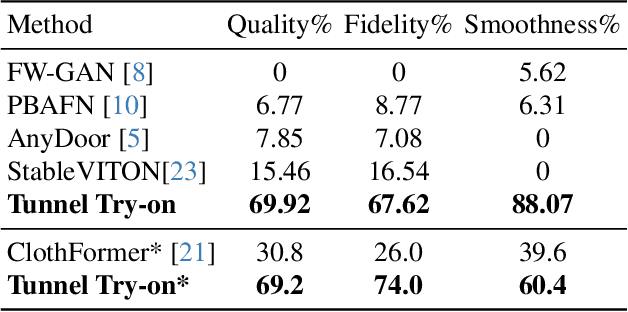
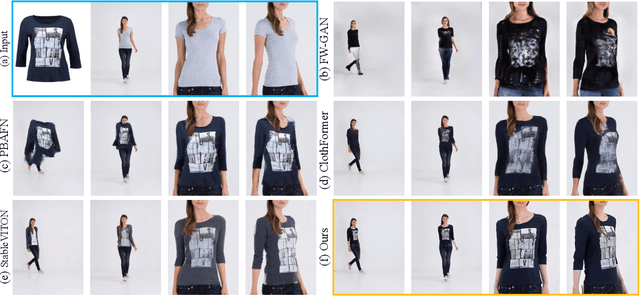
Abstract:Video try-on is a challenging task and has not been well tackled in previous works. The main obstacle lies in preserving the details of the clothing and modeling the coherent motions simultaneously. Faced with those difficulties, we address video try-on by proposing a diffusion-based framework named "Tunnel Try-on." The core idea is excavating a "focus tunnel" in the input video that gives close-up shots around the clothing regions. We zoom in on the region in the tunnel to better preserve the fine details of the clothing. To generate coherent motions, we first leverage the Kalman filter to construct smooth crops in the focus tunnel and inject the position embedding of the tunnel into attention layers to improve the continuity of the generated videos. In addition, we develop an environment encoder to extract the context information outside the tunnels as supplementary cues. Equipped with these techniques, Tunnel Try-on keeps the fine details of the clothing and synthesizes stable and smooth videos. Demonstrating significant advancements, Tunnel Try-on could be regarded as the first attempt toward the commercial-level application of virtual try-on in videos.
Cell Variational Information Bottleneck Network
Mar 29, 2024
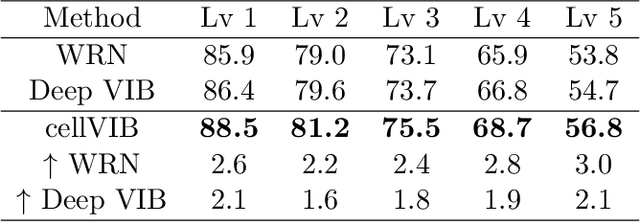


Abstract:In this work, we propose Cell Variational Information Bottleneck Network (cellVIB), a convolutional neural network using information bottleneck mechanism, which can be combined with the latest feedforward network architecture in an end-to-end training method. Our Cell Variational Information Bottleneck Network is constructed by stacking VIB cells, which generate feature maps with uncertainty. As layers going deeper, the regularization effect will gradually increase, instead of directly adding excessive regular constraints to the output layer of the model as in Deep VIB. Under each VIB cell, the feedforward process learns an independent mean term and an standard deviation term, and predicts the Gaussian distribution based on them. The feedback process is based on reparameterization trick for effective training. This work performs an extensive analysis on MNIST dataset to verify the effectiveness of each VIB cells, and provides an insightful analysis on how the VIB cells affect mutual information. Experiments conducted on CIFAR-10 also prove that our cellVIB is robust against noisy labels during training and against corrupted images during testing. Then, we validate our method on PACS dataset, whose results show that the VIB cells can significantly improve the generalization performance of the basic model. Finally, in a more complex representation learning task, face recognition, our network structure has also achieved very competitive results.
Wear-Any-Way: Manipulable Virtual Try-on via Sparse Correspondence Alignment
Mar 19, 2024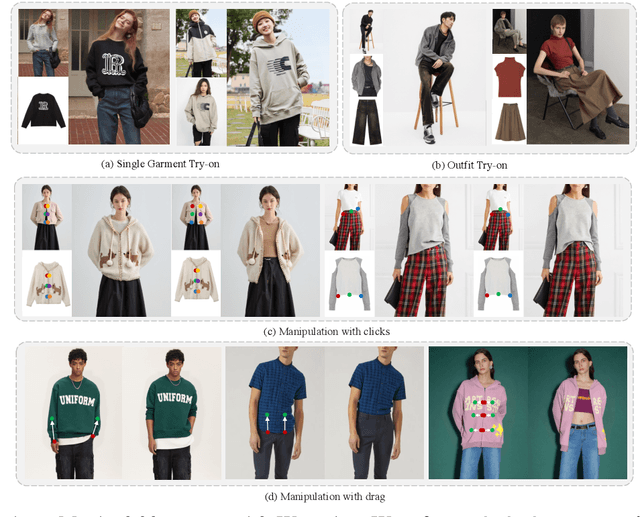

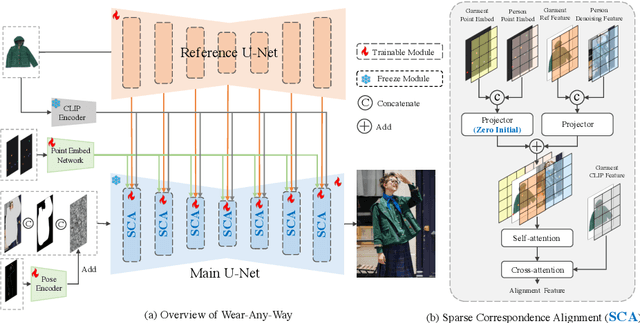

Abstract:This paper introduces a novel framework for virtual try-on, termed Wear-Any-Way. Different from previous methods, Wear-Any-Way is a customizable solution. Besides generating high-fidelity results, our method supports users to precisely manipulate the wearing style. To achieve this goal, we first construct a strong pipeline for standard virtual try-on, supporting single/multiple garment try-on and model-to-model settings in complicated scenarios. To make it manipulable, we propose sparse correspondence alignment which involves point-based control to guide the generation for specific locations. With this design, Wear-Any-Way gets state-of-the-art performance for the standard setting and provides a novel interaction form for customizing the wearing style. For instance, it supports users to drag the sleeve to make it rolled up, drag the coat to make it open, and utilize clicks to control the style of tuck, etc. Wear-Any-Way enables more liberated and flexible expressions of the attires, holding profound implications in the fashion industry.
Enhancing Cross-domain Click-Through Rate Prediction via Explicit Feature Augmentation
Nov 30, 2023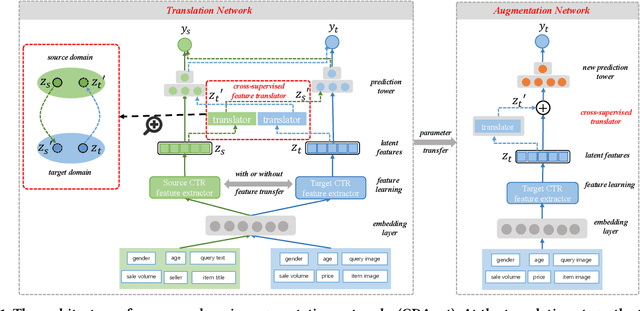
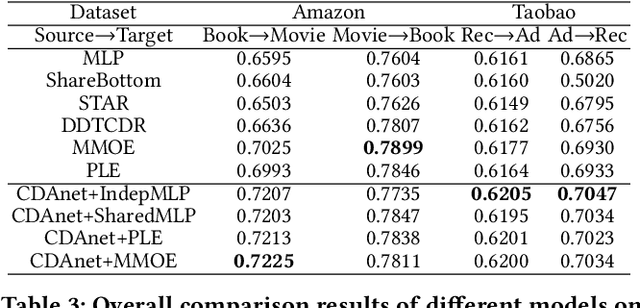


Abstract:Cross-domain CTR (CDCTR) prediction is an important research topic that studies how to leverage meaningful data from a related domain to help CTR prediction in target domain. Most existing CDCTR works design implicit ways to transfer knowledge across domains such as parameter-sharing that regularizes the model training in target domain. More effectively, recent researchers propose explicit techniques to extract user interest knowledge and transfer this knowledge to target domain. However, the proposed method mainly faces two issues: 1) it usually requires a super domain, i.e. an extremely large source domain, to cover most users or items of target domain, and 2) the extracted user interest knowledge is static no matter what the context is in target domain. These limitations motivate us to develop a more flexible and efficient technique to explicitly transfer knowledge. In this work, we propose a cross-domain augmentation network (CDAnet) being able to perform explicit knowledge transfer between two domains. Specifically, CDAnet contains a designed translation network and an augmentation network which are trained sequentially. The translation network computes latent features from two domains and learns meaningful cross-domain knowledge of each input in target domain by using a designed cross-supervised feature translator. Later the augmentation network employs the explicit cross-domain knowledge as augmented information to boost the target domain CTR prediction. Through extensive experiments on two public benchmarks and one industrial production dataset, we show CDAnet can learn meaningful translated features and largely improve the performance of CTR prediction. CDAnet has been conducted online A/B test in image2product retrieval at Taobao app, bringing an absolute 0.11 point CTR improvement, a relative 0.64% deal growth and a relative 1.26% GMV increase.
 Add to Chrome
Add to Chrome Add to Firefox
Add to Firefox Add to Edge
Add to Edge